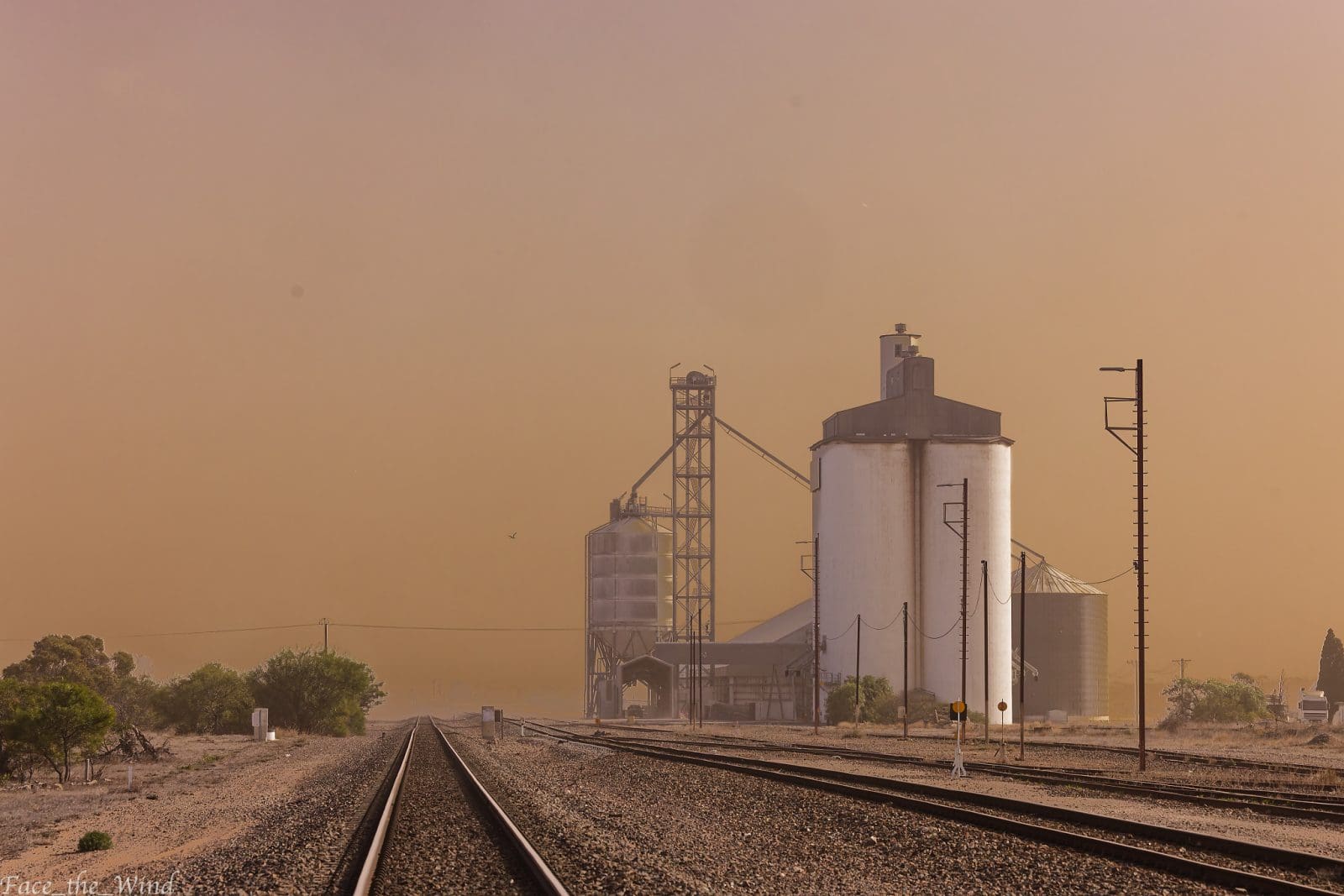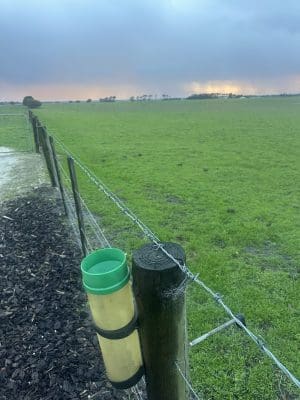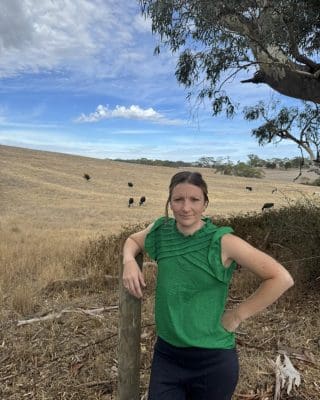
Wind brought dust and then 8mm of rain to the Tailem Bend district in SA’s Murray-Mallee. Photo: Face the Wind Photography/Peter Blacket
ALMOST 80 percent of livestock producers responding to a Livestock SA survey have undertaken varying levels of destocking and 6pc have moved all stock off farm.
As South Australia’s fodder reserves run low and many farmers continue the wait for a rain to germinate dry-sown crops, calls from SA’s farming lobby for help from the SA and Federal Government are increasing.
On the bright side, rain in the 24 hours to 9am today will get some crops up and away, and registrations include: Bordertown 15mm; Burra 16mm; Callington Hill 17mm; Clare 14mm; Farrell Flat 22mm; Mt Gambier 15mm, and Paskeville 10mm.
However, ungerminated crops are still in the majority in SA, and heading for the last fortnight where rain will get them going to potentially return an average yield.
For pastures, particularly in the colder South East, overnight temperatures have already dropped into the low single digits, and winter’s arrival next week will limit growth.
Graziers feel the pinch
Results just released from 430 respondents to a Livestock SA survey which closed May 19 indicate the enormity of the drought’s impact on graziers and mixed farmers.
Key findings are:
- 78 percent have undertaken varying levels of destocking;
- 6pc have already fully destocked;
- 26pc have spent over $100,000 on fodder, with 4pc spending more than $400,000;
- Fodder has been trucked from more than 100km away by 52pc of respondents, more than 500km by 6pc, and from interstate suppliers by 8pc.
- 64pc rated the importance of freight support as seven or higher on a scale of 1-10, with 10 being the highest.
Ahead of Federal Minister for Agriculture Julie Collins visiting SA this week at the invitation of Grain Producers SA , Livestock SA, GPSA, and other representative bodies are lobbying for more assistance.

With 27mm, Kongorong in the South East was one of few locations in SA to get more than 25mm of rain over recent days. Photo: Charles Wallis
SA Minister for Primary Industries Clare Scriven has been in discussion with state-based bodies, including Livestock SA.
“Livestock SA has written to the Minister Scriven about these results and welcomes the opportunity to work with the South Australian and Australian Governments to develop a practical, immediate and non-market distortionary freight support program for drought-impacted producers in our state,” Livestock SA said.
Petition started
Murray-Mallee mixed farmer Wade Boughen has launched a petition calling for the SA Premier Peter Malinauskas to declare drought in SA.
With family, he runs the Kamora Park Poll Merino Stud, plus a commercial Merino flock, and farms around 1200ha for fodder and cash crops at Sandalwood in the Murray-Mallee.
“We haven’t sown anything this year; it’s just too dry,” Mr Boughen said.
“We’ve got grain and hay from last year, and we haven’t reduced our breeder numbers, but we’re getting low on hay.”
The family’s ewes are grazing on stubble and getting supplementary hay, normal for this time of year, during lambing, and bores are providing adequate water.
Without a crop up and away, the Boughens are relying entirely on sheep for their income and, like so many SA graziers and mixed farmers, have no feed growing in paddocks.
“When we run out, where’s the grain and hay going to come from?”
Mr Boughen said the family was not able to apply for drought assistance because of one off-farm income, which prevents the business from receiving the Farm Household Allowance and associated SA Government support.
He created the petition on May 14, and as of noon today it had close to 4750 signatures.
“I started it to see if we could make a difference.”
Pressure from SA Opposition
The Malinauskas Government has made $73 million available to SA producers in its Drought Support Package, with $55M announced last month, and $18M announced in November.
The package includes rebates of up to $20,000 for on-farm drought infrastructure, such as grain silos, rebates on some state levies and fees for those on Farm Household Allowance, and transport subsidies for charities donating fodder.

SA Shadow Minister for Primary Industries Nicola Centofanti.
SA’s Shadow Minister for Primary Industries Nicola Centofanti is calling for the SA Government to expand its support for drought-hit producers.
“I understand the frustration driving the current petition — producers are calling out for clear acknowledgment of the crisis and simpler, faster access to support,” Ms Centofanti said.
“We’ve consistently called on the State Government to declare the drought a State of Emergency to recognise the scale of hardship facing farmers across South Australia.
“This wouldn’t just be symbolic; it could unlock or expedite meaningful support like no and low-interest concessional loans, council rate rebates, subsidies for fodder transport and water carting, or relief from state government charges not tied to the Farm Household Allowance.”
Ms Centofanti said while the 2013 National Drought Agreement removed the need for formal declarations to access some types of assistance, a declaration still played an important role.
“It brings public attention, drives coordination between governments, and builds confidence in the delivery of support.
“Farmers are telling me that existing programs are missing the mark, and without a formal declaration, we risk falling short of what’s needed.
“The response must match the reality on the ground, and it must get to those who need it, quickly.”
Grain Central: Get our free news straight to your inbox – Click here

All very well for the Premier to make the big announcement of the South Road project, but is does little for farmers struggling through crippling drought. What about regional roads also? $15.4billion for the South Road project in comparison to a few million to help a vital industry to supply people with food to live is a drop in the ocean.
Our problems started a year ago, with a poor season and poor sheep prices. However, our ability to access assistance is hindered by the previous year which was quite good, and that tax return (about to be submitted) looks good.
We bought fodder for reserve, put money aside, and looked well off. But now we have no reserves of feed or finance. We lent some money to our daughter as they have more trouble than us. We have destocked almost entirely. There is very little crop sown. But, until our current financial year’s figures become available, we won’t fit the criteria for help.
Even if we could access low interest loans or farm household assistance I’m not sure how we will make it through the next 12 months. We’ve never sought support before, but this year we have no choice. And it’s looking like we won’t get any.
There are many in the same position as us, mostly brought about because we saved in a good time, which then bites us the following financial years.